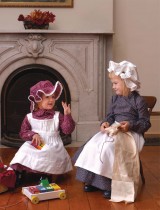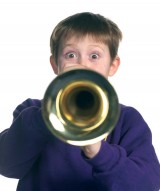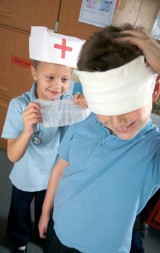Try Juliet Desailly’s ideas for teaching cross curricular history and immerse children in the past...
There are a number of good reasons for taking a cross-curricular approach to history. In my experience, it encourages children to be more involved in their learning, to make connections between different subjects and apply the skills they have learned in one area to another.
Of course, working in a cross-curricular way also makes the best use of time in an overcrowded curriculum. If you make clear which key skills you are developing and what knowledge and understanding the children are gaining, it is possible to plan activities with parallel learning objectives in more than one subject.
Many schools have been applying these principles to their lesson planning for some time now, and with the Rose report recommending
a change to a curriculum based around six areas of learning, rather than specific subjects, there will be even more scope in the future for good cross-curricular teaching.
Illustrate an historical story
Choose a really good narrative text, based in the period you are studying, as a focus for work in literacy hour. Ask the children to imagine they are going to illustrate the book. They should research how the characters would have dressed, what their homes would have looked like etc to produce an authentic illustration for a significant part of the story.
 Step into a picture
Step into a picture
Give each child, or pair of children, an historic picture featuring more than one person. Then hand out a circle of plain paper about the size of a 2p piece to every pupil and tell them to draw their face on it.
Ask the children to choose one of the people in the picture and place the drawing of their face on that person, thus “stepping into” the scene. Having done this, they should think about what they can see and hear as that person. Go through all the senses; what can they taste, touch and smell? And what are they feeling? Ask the children to generate really good descriptive phrases for each sense. This can be developed into poetry or narrative writing.
Bring pictures to life
As a warm up activity, ask the children to use their bodies to make a still picture of someone who is very tired, very angry etc.
Place pictures of people from the past who you want the children to identify with on the floor. (This works particularly well with pictures of rich and poor Victorian children.) Pupils should then walk around and look at the pictures, thinking about who the people might be, what their lives might be like and how they spend their days.
Ask the children to choose a person from one of the images to make a still picture of. After relaxing the pose, children should take it up again, but this time they are going to say ‘My name is…’ and add the name of the person they have chosen. Then ask them to make the still picture again and this time to speak out loud the thought that is uppermost in that person’s mind.
When the children have done this all at once, go round and ask individuals to speak their thoughts again by tapping them on the shoulder. If you like, you can then ask the children to add one stylised gesture to the spoken thought, perhaps to turn away or put their head in their hands. They then share these gestures one after another.
 Sound the trumpets!
Sound the trumpets!
A Tudor monarch would often be greeted with a fanfare. Why? (It’s imposing, creates a sense of occasion and importance, adds to the monarch’s status, makes everyone stop and pay attention etc.) Using picture sources, ask the children to research instruments that were available in Tudor times. Which might they have chosen for a fanfare and why? (Brass and drums are often used for fanfares as they are loud and striking.) Ask the children to use the most appropriate instruments they have to create their own fanfares. Choose some children to be royalty and courtiers to enter to the fanfares.
March to the beat
Processions in Ancient Egypt often involved music and dancing. Discuss occasions where this happens today (e.g. carnivals). You could also watch video clips of dancing in a procession.
Explore the types of instruments the ancient Egyptians might have played in a procession (e.g. clappers, shakers, bells). Ask the children to identify the elements of music necessary for dancing (rhythm, steady beat). In groups, children should then use similar percussion instruments to compose a piece of music to dance to in a procession.
Use the music to form their own processional dance.
Analyse portraits
Show the children the portrait of Queen Elizabeth I by Marcus Gheeraerts or the Armada Portrait. Ask the children what messages the artist might have wanted to convey about Elizabeth. What is the significance of her standing on the map or resting her hand on the globe? What about the richness or style of her clothes, the jewels, her hairstyle? What other props are evident? Or background images?
Look at some other Tudor portraits, try to provide a range that might imply, for example, scholar, family man or romantic. Ask the children to analyse the symbolism of the setting, props, pose, clothing etc in the same way.
Ask the children to decide how they would like to be perceived in a portrait of themselves; sportsperson, good friend, reader, outgoing, thoughtful? What aspects of their interests and personalities would they most want to express to others? Is there a perception of themselves they would like to contradict? Ask them to design their own self portrait using symbolism to show the aspects they want to emphasise.
Examine old maps
Look at historic maps and compare them with modern maps of the same region. If possible, use maps of places the children can actually visit. Discuss how the land was used. What has changed and what has stayed the same? Why might some of the changes have occurred?
Engaging role play areas for KS1 and KS2…
Below stairs in a victorian house
The children are servants in a Victorian/Edwardian house. Begin by taking on the role of a housekeeper training a new batch of servants, they can mime scrubbing floors, peeling vegetables, laying fires, ironing with a flat iron etc. Include outside jobs too, like grooming horses or gardening. Provide mob caps, aprons, waistcoats, flat caps and domestic equipment. One child is bound to take on the bossy housekeeper role.
 A hospital in the crimean war
A hospital in the crimean war
There’s never a shortage of volunteers to be wounded soldiers!
An air raid shelter
Children can take their work in there to pass the time! Try having an air raid routine too. Give all the children tasks to do when the siren sounds e.g. air raid wardens put their tin hats on, some children have to draw the blackout curtains, others collect buckets of sand or crouch under the tables. Have a siren sound effect and use it randomly during lessons to see how quickly all the children can get to their positions.
If you’ve enjoyed Juliet Desailly’s ideas for teaching cross curricular history, why not inquire about a school visit? You can find details of Juliet’s educational services at http://www.julietdesailly.co.uk
